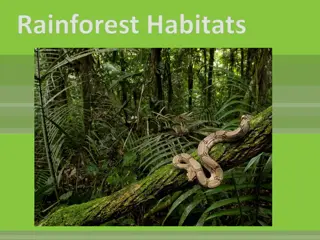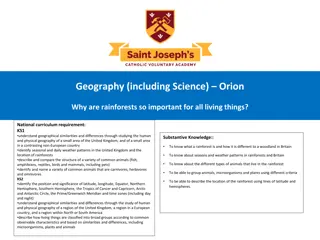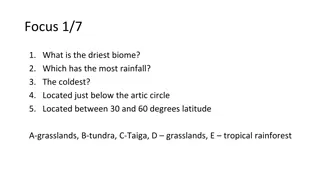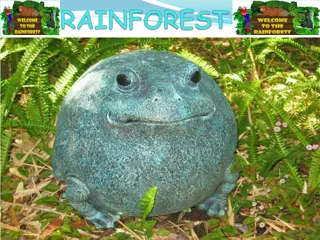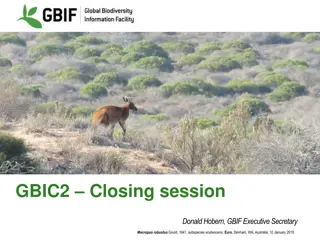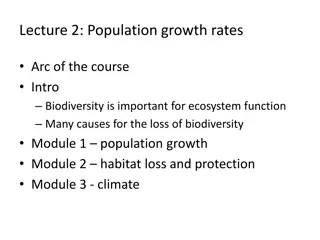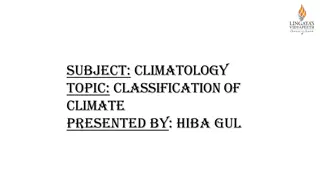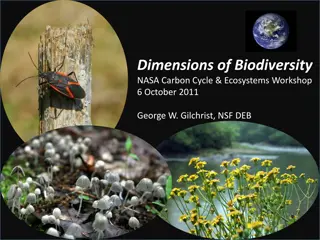Exploring the Biodiversity of Tropical Rainforests
Discover the lush world of tropical rainforests, rich in unique flora and fauna. Learn about their complex structure, diverse vegetation, and the incredible array of species they support. Delve into the fascinating characteristics and the importance of these biomes in sustaining global biodiversity.
Download Presentation

Please find below an Image/Link to download the presentation.
The content on the website is provided AS IS for your information and personal use only. It may not be sold, licensed, or shared on other websites without obtaining consent from the author. Download presentation by click this link. If you encounter any issues during the download, it is possible that the publisher has removed the file from their server.
E N D
Presentation Transcript
Lecture 4 Forests of the World (III)
Tropical Rain Forest The equatorial or tropical broadleaf evergreen rainforest is mainly found in S. America, central Africa and the equatorial west coast of Africa, west coast of India, Burma, Malaysia, Indo-China Indonesia, Philippines, and Papua New Guinea.
Tropical Rain Forest Image courtesy of Bart van der Kamp The tropical rainforest is the earth s most complex biome in terms of structure and species diversity. Mean monthly temperatures are in excess of 18 degrees Celsius and annual rainfall is generally more than 2500 mm. The growing season is year round.
Tropical Rain Forest Forest is all aged and the vegetation is multi- layered, generally with three layers of trees a shrub layer and a ground layer. MAYBE!!! Not Always True.
Tropical Rain Forest Vegetation occupies all of the growing space vertically and horizontally. Growth forms include epiphytes; lianas; climbers; stranglers; parasites and saprophytes.
Tropical Rain Forest Tropical Rain Forest Characteristics of many tropical trees include: - buttressed trunks - large leaves in the lower strata of the forest; small leaves in the upper strata - thin bark - large fleshy fruits.
Tropical Rain Forest Tropical rainforests are very diverse biologically: - 60% of all plant species - 80% of all insect species - 90% of all primates - hundreds of thousands, possibly millions, of species yet to identify.
Tropical Rain Forest Diversity of tropical rain forest includes tree species. Hundreds of genera and dozens of families are represented exhibiting very heterogeneous characteristics.
Tropical Rain Forest 6000 tree species in Brazilian Amazon. 50-100 different tree species per hectare of which only 1 or 2 may be of commercial importance. - 300 species per hectare have been recorded in Peruvian Amazon. - 700 species per hectare in Kalimantan (approximately the same number as in the whole of North America)
Tropical Rain Forest Tropical forests generally exhibit low commercial productivity of only 0.3-0.5 m3/ha/annum.
Tropical Rain Forest Soils: - generally infertile - deeply weathered and heavily leached - often bright red in colour due to concentrations of iron and aluminum oxides - little accumulation of organic matter due to rapid bacterial breakdown (7-8 months)
Tropical Rain Forest Tropical forests have come under increasingly heavy cultural pressures in recent decades: - logging exploitation in West Africa and S.E. Asia, less so in S. America. Brazilian Amazon has over 50 billion m3 of timber but log production is only about 4 million m3/annum. - rapid deforestation is resulting from slash and burn, shifting cultivation that is exacerbated by rising populations
Tropical Rain Forest - clearing the forest, particularly in the Amazon, for large scale grazing, mining exploration and infrastructural development. http://www.commercialpressuresonland.org/press/amazon-rainforests-pay-price-demand-beef- soars
Tropical Rain Forest When tropical rain forests are cleared of vegetation they do not regenerate easily and do not regain their original structure and composition. Nutrients are leached from soils that are already nutrient deficient. Soils become compacted and harden (laterization). Water logging and erosion occur.
Tropical Rain Forest Image courtesy of Howard Harshaw Cleared tropical rain forests frequently revert permanently to grasslands and derived savanna typified by palm trees and shrubs.
Tropical Seasonal Forest The tropical moist deciduous (seasonal) forests are similar to the evergreen tropical rain forest in terms of temperature, growing season and diversity of species composition. However, they are typified by pronounced dry and wet (monsoon) seasons. Many species lose their leaves during the dry season. The zone is extensive in South America, South-central Africa, India and parts of S.E Asia.
Tropical Seasonal Forest The tropical moist deciduous zone has been heavily exploited for commercially valuable species such as teak and sal. It is an area of high population densities and is heavily exploited for fuel wood. Much of the area has been permanently degraded. It is an increasingly important area for the establishment of fast-growing, intensively managedplantations.
Savanna Savannas (dry forests) are very extensive. They are the transition between the tropical high forests and grasslands.
Savanna Monthly mean temperatures average above 18 degrees Celsius and annual rainfall varies between 700 and 1200 mm. Day time temperatures are higher than in the moist tropics and evapo-transpiration rates are higher. There is generally a pronounced dry season.
Savannas Image courtesy of Howard Harshaw Great diversity of tree species but trees are slow growing, of poor form (twisted) and short. Trees are drought resistant, fire resistant and browsing resistant. Soils generally are of low fertility.
Savannas Tree cover varies from closed canopy forest in the moister areas, through open forest to open, park-like woodland. Large areas of dry forest are the result of human activity that destroys forest. Image courtesy of Howard Harshaw
Savannas Image courtesy of Howard Harshaw Dry forest types are mainly located in less developed countries. Populations are high and put increasing pressures on the land base. Very little commercial exploitation but heavily used for fuel-wood and other domestic purposes.



